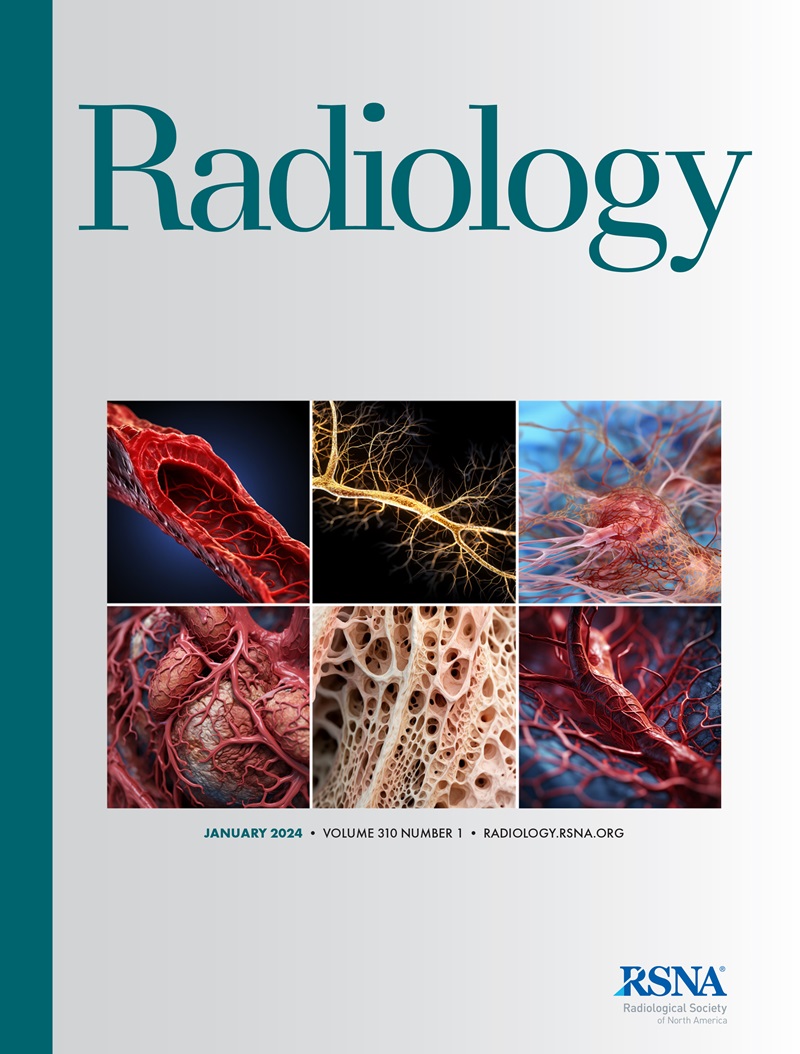Sven S Walter, Jan Vosshenrich, Tatiane Cantarelli Rodrigues, Danoob Dalili, Benjamin Fritz, Richard Kijowski, Eun Hae Park, Aline Serfaty, Steven E Stern, Inge Brinkmann, Gregor Koerzdoerfer, Jan Fritz
求助PDF
{"title":"Deep Learning Superresolution for Simultaneous Multislice Parallel Imaging-Accelerated Knee MRI Using Arthroscopy Validation.","authors":"Sven S Walter, Jan Vosshenrich, Tatiane Cantarelli Rodrigues, Danoob Dalili, Benjamin Fritz, Richard Kijowski, Eun Hae Park, Aline Serfaty, Steven E Stern, Inge Brinkmann, Gregor Koerzdoerfer, Jan Fritz","doi":"10.1148/radiol.241249","DOIUrl":null,"url":null,"abstract":"<p><p>Background Deep learning (DL) methods can improve accelerated MRI but require validation against an independent reference standard to ensure robustness and accuracy. Purpose To validate the diagnostic performance of twofold-simultaneous-multislice (SMSx2) twofold-parallel-imaging (PIx2)-accelerated DL superresolution MRI in the knee against conventional SMSx2-PIx2-accelerated MRI using arthroscopy as the reference standard. Materials and Methods Adults with painful knee conditions were prospectively enrolled from December 2021 to October 2022. Participants underwent fourfold SMSx2-PIx2-accelerated standard-of-care and investigational DL superresolution MRI at 3 T. Seven radiologists independently evaluated the MRI examinations for overall image quality (using Likert scale scores: 1, very bad, to 5, very good) and the presence or absence of meniscus and ligament tears. Articular cartilage was categorized as intact, or partial or full-thickness defects. Statistical analyses included interreader agreements (Cohen κ and Gwet AC2) and diagnostic performance testing used area under the receiver operating characteristic curve (AUC) values. Results A total of 116 adults (mean age, 45 years ± 15 [SD]; 74 men) who underwent arthroscopic surgery within 38 days ± 22 were evaluated. Overall image quality was better for DL superresolution MRI (median Likert score, 5; range, 3-5) than conventional MRI (median Likert score, 4; range, 3-5) (<i>P</i> < .001). Diagnostic performances of conventional versus DL superresolution MRI were similar for medial meniscus tears (AUC, 0.94 [95% CI: 0.89, 0.97] vs 0.94 [95% CI: 0.90, 0.98], respectively; <i>P</i> > .99), lateral meniscus tears (AUC, 0.85 [95% CI: 0.78, 0.91] vs 0.87 [95% CI: 0.81, 0.94], respectively; <i>P</i> = .96), and anterior cruciate ligament tears (AUC, 0.98 [95% CI: 0.93, >0.99] vs 0.98 [95% CI: 0.93, >0.99], respectively; <i>P</i> > .99). DL superresolution MRI (AUC, 0.78; 95% CI: 0.75, 0.81) had higher diagnostic performance than conventional MRI (AUC, 0.71; 95% CI: 0.67, 0.74; <i>P</i> = .002) for articular cartilage lesions. DL superresolution MRI did not introduce hallucinations or erroneously omit abnormalities. Conclusion Compared with conventional SMSx2-PIx2-accelerated MRI, fourfold SMSx2-PIx2-accelerated DL superresolution MRI in the knee provided better image quality, similar performance for detecting meniscus and ligament tears, and improved performance for depicting articular cartilage lesions. © RSNA, 2025 <i>Supplemental material is available for this article.</i> See also the editorial by Nevalainen in this issue.</p>","PeriodicalId":20896,"journal":{"name":"Radiology","volume":"314 1","pages":"e241249"},"PeriodicalIF":12.1000,"publicationDate":"2025-01-01","publicationTypes":"Journal Article","fieldsOfStudy":null,"isOpenAccess":false,"openAccessPdf":"","citationCount":"0","resultStr":null,"platform":"Semanticscholar","paperid":null,"PeriodicalName":"Radiology","FirstCategoryId":"3","ListUrlMain":"https://doi.org/10.1148/radiol.241249","RegionNum":1,"RegionCategory":"医学","ArticlePicture":[],"TitleCN":null,"AbstractTextCN":null,"PMCID":null,"EPubDate":"","PubModel":"","JCR":"Q1","JCRName":"RADIOLOGY, NUCLEAR MEDICINE & MEDICAL IMAGING","Score":null,"Total":0}
引用次数: 0
引用
批量引用
Abstract
Background Deep learning (DL) methods can improve accelerated MRI but require validation against an independent reference standard to ensure robustness and accuracy. Purpose To validate the diagnostic performance of twofold-simultaneous-multislice (SMSx2) twofold-parallel-imaging (PIx2)-accelerated DL superresolution MRI in the knee against conventional SMSx2-PIx2-accelerated MRI using arthroscopy as the reference standard. Materials and Methods Adults with painful knee conditions were prospectively enrolled from December 2021 to October 2022. Participants underwent fourfold SMSx2-PIx2-accelerated standard-of-care and investigational DL superresolution MRI at 3 T. Seven radiologists independently evaluated the MRI examinations for overall image quality (using Likert scale scores: 1, very bad, to 5, very good) and the presence or absence of meniscus and ligament tears. Articular cartilage was categorized as intact, or partial or full-thickness defects. Statistical analyses included interreader agreements (Cohen κ and Gwet AC2) and diagnostic performance testing used area under the receiver operating characteristic curve (AUC) values. Results A total of 116 adults (mean age, 45 years ± 15 [SD]; 74 men) who underwent arthroscopic surgery within 38 days ± 22 were evaluated. Overall image quality was better for DL superresolution MRI (median Likert score, 5; range, 3-5) than conventional MRI (median Likert score, 4; range, 3-5) (P < .001). Diagnostic performances of conventional versus DL superresolution MRI were similar for medial meniscus tears (AUC, 0.94 [95% CI: 0.89, 0.97] vs 0.94 [95% CI: 0.90, 0.98], respectively; P > .99), lateral meniscus tears (AUC, 0.85 [95% CI: 0.78, 0.91] vs 0.87 [95% CI: 0.81, 0.94], respectively; P = .96), and anterior cruciate ligament tears (AUC, 0.98 [95% CI: 0.93, >0.99] vs 0.98 [95% CI: 0.93, >0.99], respectively; P > .99). DL superresolution MRI (AUC, 0.78; 95% CI: 0.75, 0.81) had higher diagnostic performance than conventional MRI (AUC, 0.71; 95% CI: 0.67, 0.74; P = .002) for articular cartilage lesions. DL superresolution MRI did not introduce hallucinations or erroneously omit abnormalities. Conclusion Compared with conventional SMSx2-PIx2-accelerated MRI, fourfold SMSx2-PIx2-accelerated DL superresolution MRI in the knee provided better image quality, similar performance for detecting meniscus and ligament tears, and improved performance for depicting articular cartilage lesions. © RSNA, 2025 Supplemental material is available for this article. See also the editorial by Nevalainen in this issue.

 求助内容:
求助内容: 应助结果提醒方式:
应助结果提醒方式:


